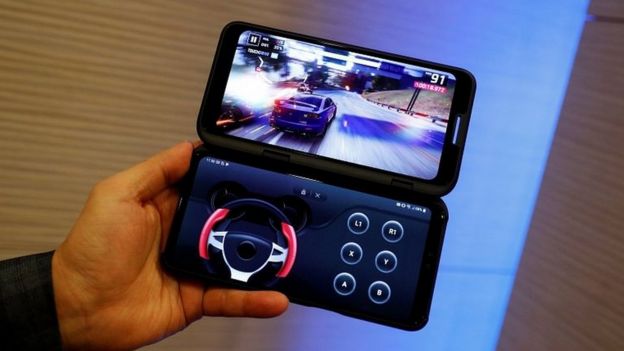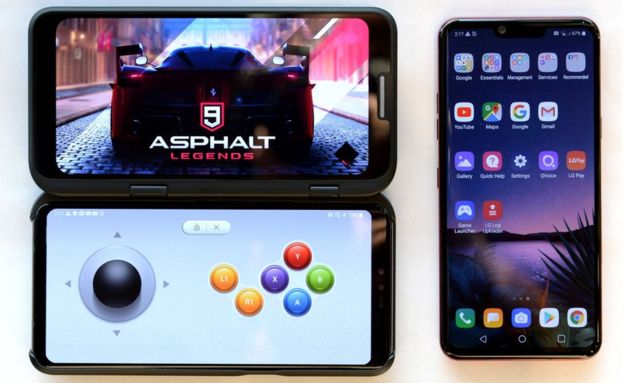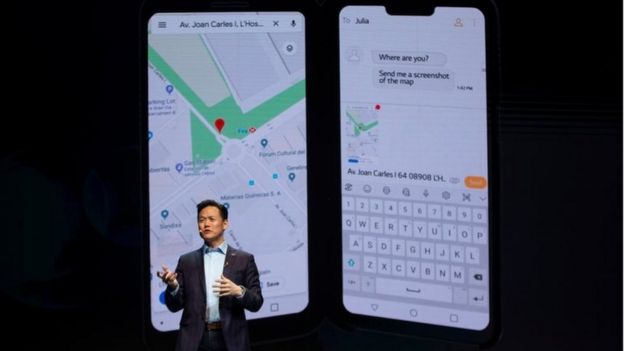LG has showed off a two-screened smartphone following earlier reveals by Samsung, Huawei and Xiaomi.
But while the South Korean firm's rivals have demoed hybrid phone-tablet designs that involve flexible displays and complex hinges, LG has taken a simpler approach.
It has created a second display as a detachable accessory.
The end result may look less elegant thanks to the gap between the screens, but it is likely to cost less.
The 6.2in (15.7cm) V50 ThinQ handset and its matching Dual Screen add-on both use OLED (organic light-emitting diode) technology.
At its Barcelona press event, LG suggested the two could be paired to provide:
- a touchscreen control pad for video games
- a group call set-up in which a caller could see two other participants full-screen
- a YouTube livestream arrangement in which vloggers could see the footage they were capturing on one display and comments from their followers on the other

The add-on connects to the handset via three pogo pins on its rear, leaving the phone's USB-C port free.
It can be positioned at two angles - 104 degrees or flat at 180 degrees - to the main display when in use.
It can also be closed so that it lies on top of the phone to act as a protective case.
LG has yet to reveal the cost or release date of the equipment but did reveal other specs including 5G network compatibility and three rear cameras.
The announcement came at LG's press event on the eve of the Mobile World Congress trade show.

"The game controller use case is interesting," commented industry analyst Patrick Moorhead.
He said taking a screenshot and emailing it also worked, but after using it was "torn on if it's a gimmick or useful".
Others noted that adding the Dual Display made the phone nearly twice as thick to hold and 70% heavier.
LG had earlier said it had considered releasing a true foldable-screened phone, but had decided that it was too early to do so and that it preferred to focus on regaining lost market share.

The company also unveiled the G8 - a smartphone distinguished by its introduction of a palm-scanning camera on its front.
This acts as an alternative to a fingerprint sensor, unlocking the device by tracking the blood in a user's veins via infrared light.
The owner's palm does not have to come into contact with the handset for this to work, meaning it can be unlocked while lying flat on a table without having to be picked up.
Latest Stories
-
Samuel Awuku resigns as Director-General of National Lottery Authority
7 seconds -
AFCON qualification disappointment a degeneration of GFA – Osei Palmer
17 minutes -
South Korea begins impeachment trial of suspended president
19 minutes -
Trump would have been convicted if not elected, DoJ report says
26 minutes -
Daily Insights for CEOs: The role of digital transformation in business growth
33 minutes -
Teddy Osei of Osibisa fame dead
1 hour -
Alexander Djiku hails Fenerbahce’s effort in hard-fought win over Konyaspor
2 hours -
U-20 World Cup 2009: Black Satellites players reject payment on matured investment
2 hours -
We reaffirm our unwavering support for government’s efforts to ensure stable, affordable electricity – IPGG
2 hours -
Baseball: Ghana’s Golden Palms retain African Youth Championship title
2 hours -
ORAL is set up to settle political goals, revoke it – Ansah-Asare
2 hours -
Hamas has accepted a draft agreement for a Gaza ceasefire and the release of hostages, officials say
2 hours -
Joy Prime’s Changes Wedding Gown giveaway: Rose Abaya rocks gifted gown from Peace Bridals
2 hours -
This economy has to deliver jobs for Ghanaians – Dr Theo Acheampong
2 hours -
I went to Shatta Wale for advice during my campaign – A Plus
2 hours

